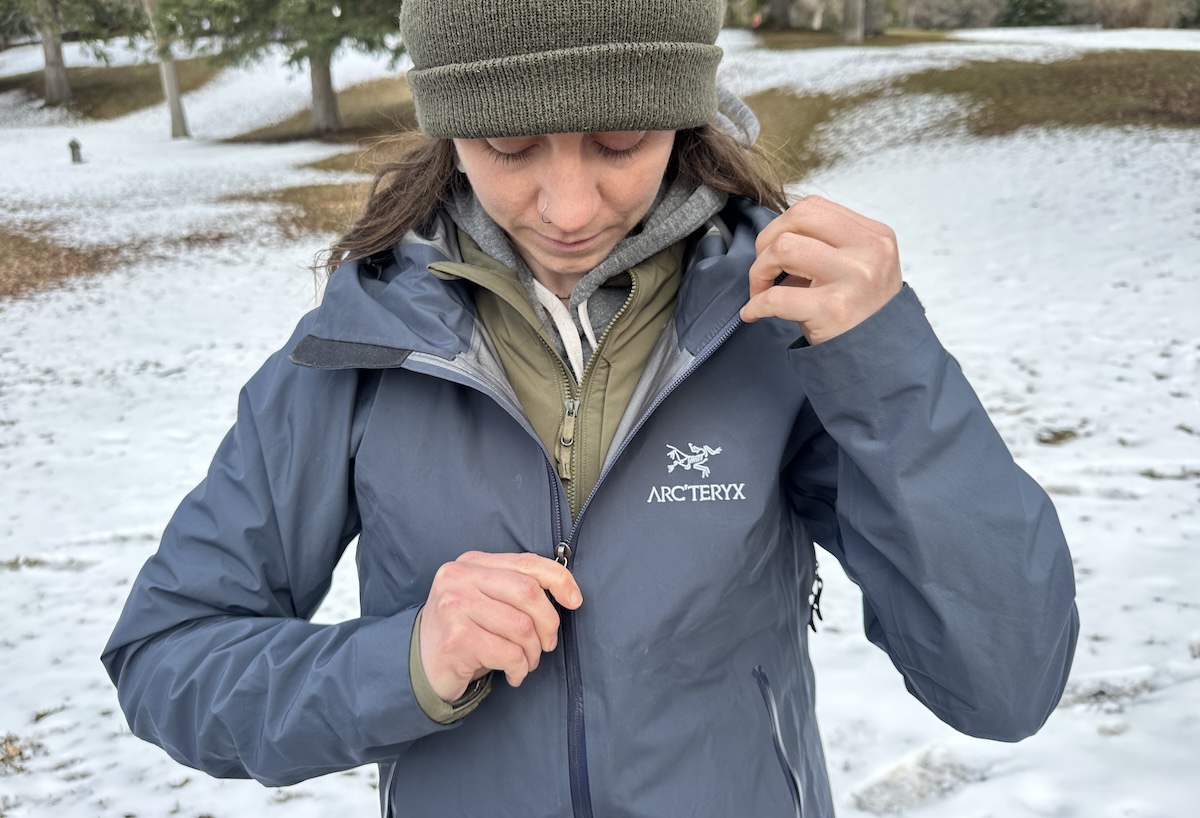

Switchback Travel (Matt Maar)


Switchback Travel (Matt Maar)
Price: $300
Weight: 11.1 oz. (women's)
Insulation: Coreloft Stretch (40g & 25g)
What we like: Serves as a great midlayer for skiing or a nice standalone piece in favorable conditions; excellent breathability and mobility for high-output use.
What we don’t: Limited warmth and wind resistance.
See the Men's Arc'teryx Allium Insulated Jacket
This winter, I went on the hunt for a hoodless synthetic jacket to wear as a midlayer for skiing. Along with being trim enough to layer overtop, I wanted the jacket to be breathable and stretchy for higher-output activities without looking overly technical when worn on its own. Out of all the synthetic jackets I tested, the Arc'teryx Allium fit the bill the best. It's got great mobility, sheds light moisture and grime, and is easy to pair underneath a shell thanks to its streamlined build. It's not particularly warm for standalone use, but it's an excellent layering piece and shoulder-season companion. Below I break down the Allium's overall performance. To see how it stacks up to the competition, check out our articles on the best synthetic jackets, best women's synthetic jackets, and best midlayers.
Editor's note: We tested the women's Allium Insulated Jacket, which is currently unavailable through Arc'teryx's U.S. site. You can see the Canadian product page here for more details, but we've linked to the men's model (which can be shipped within the U.S.) throughout our review below.
The Arc'teryx Allium is a non-baffled synthetic jacket that's packed with a mix of 40-gram (g) Coreloft Stretch insulation at the front and arms, with thinner 25g along the side panels and back. Overall warmth wasn't one of my primary concerns with the Allium since I was looking for a midlayer to complete a three-part layering system (baselayer, midlayer, and shell). That said, I found the body-mapped system to be effective at maximizing warmth where you need it the most (around the core) while minimizing weight and bulk elsewhere. In sum, the Allium is a great active midlayer or standalone piece in moderate conditions, but you'll want to pair it with a warm baselayer and windproof shell in cold weather. For mid-winter use, especially if you'll be relatively sedentary, it's likely worth stepping up to a design with thicker insulation (at least 60g).

The Allium is less insulated than popular synthetic jackets like Arc'teryx's own Atom Hoody and Patagonia's popular Nano Puff, both of which use 60g fill compared to the Allium's 40g and 25g combination. I still find all three jackets work best when paired with an outer shell, but the Allium is more streamlined and not as warm, which impacts overall versatility. This past winter, I was comfortable in the Allium on its own down into the low 40s Fahrenheit. For anything colder, I paired it with a water- and windproof shell.
The Allium is fairly competitive weight-wise in the wider synthetic jacket market, checking in at 11.1 ounces for the women's version (the men's style is slightly heavier at 13.6 oz.). For comparison, the women's Atom Hoody weighs 11.3 ounces, while Patagonia's down-mimicking Nano Puff Jacket clocks in a bit lower at 10 ounces even (note: The Atom only comes in a hooded version for women, which certainly contributes to the difference). Regarding packability, the Allium lands somewhere in between the Atom and Nano Puff: more compressible than the former but less than the latter. The slightly larger packed size has been fine for me, as I'm more apt to use a true down jacket when I need to conserve weight and space.

The Allium's middling packability is the result of a few factors. First, the 50-denier (D) shell fabric is relatively thick compared to both the Atom and Nano Puff (both 20D). Second, the Coreloft Stretch insulation isn't quite as compressible as the Nano Puff's PrimaLoft Gold Eco fill, which is designed to mimic down's loft and packability. Since packed size wasn't a concern for me, I enjoyed the hardwearing shell despite the fact that it adds bulk. I wouldn't mind if the Allium were a little more packable, but it just means it's not my first choice when space is at a premium.
With its 50D nylon shell and durable water-repellent (DWR) coating, the Allium Insulated Jacket has held up well against light rain and snow. The insulation stays springy and warm when wet—one of the core benefits of synthetic compared to down fill. Paired with a ski shell, I've worn the Allium down into the high 20s Fahrenheit and remained perfectly dry and warm. On super cold resort days, the slim fit allows for easy layering underneath an insulated ski jacket.

As far as wind resistance goes, the Allium's clear emphasis on breathability means that wind bites right through the jacket. It does have the benefit of very little stitching thanks to the baffle-free shell, creating less opportunity for wind to sneak through the exterior. However, on particularly cold and windy days with biting gusts, I recommend throwing on a hardshell jacket or other windproof outer layer overtop. This will help maximize warmth since cold drafts won't make their way to your baselayers.

Arc'teryx advertises the Allium as a "freeride softshell," meaning it's designed for movement and therefore puts a strong focus on breathability. The Coreloft Stretch insulation combined with the stretchy, air-permeable nylon shell help regulate temperature by trapping warmth while still allowing air to move. The nylon liner, which is thinner than the shell at 20D, also helps, effectively wicking moisture (e.g., sweat) away from the skin while easily sliding over baselayers. All told, the Allium is a great breather and has never caused me to overheat, even during periods of heavy exertion.

The Arc'teryx Allium is a simple but functional jacket. It has two well-placed hand pockets that fit my phone, wallet, and keys, along with a chest pocket that features a hidden, inset zipper. While minimalist, the storage layout is entirely practical and contributes to the jacket's sleek silhouette. Arc'teryx also included two drawcords at the hem that are easy to adjust and do a good job creating an even cinch around the waist. I don't use them very often, but the cords are nice for protection from wind and blowing snow. Finally, it's worth noting that the Allium is only offered in a non-hooded style, which makes sense for midlayer use but limits the jacket's appeal as a standalone piece.

Arc'teryx makes some of the most premium insulated jackets on the market. They generally cost a lot, but overall performance and build quality typically line up with the price. The Allium Insulated Jacket is no exception: The stretchy nylon shell is hardwearing and good-looking, the Coreloft insulation is mapped strategically for maximum warmth and minimal weight, and everything from the zippers to the hem drawcords has a high-quality look and feel. I was initially concerned about the Allium's exterior snagging or pilling since most of my insulated jackets use a more abrasion-resistant ripstop material, but it's been a non-issue, and I appreciate the ease of movement from the stretchy weave.

Since the Allium isn't particularly packable, it doesn't spend a lot of time crushed in a backpack or stuff sack, so I haven't had to worry about the insulation maintaining its loft. For reference, after a long season of pretty frequent wear, my jacket still looks almost as good as new. Again, the 50D shell fabric does add some weight and bulk compared to options like the Arc'teryx Atom or Patagonia Nano Puff (both 20D), but I've been grateful for the sturdy materials on more casual adventures that don't demand the lightest or most compressible piece.
I absolutely love the fit of the Arc'teryx Allium. I have broad shoulders for my size, and midlayers often are either uncomfortably tight or require thin baselayers in order for me to have enough space to move around. That's not the case with the Allium, which is labeled a "regular" fit and makes it easy to layer both overtop and underneath. I've been able to wear a variety of baselayers with the Allium, including heavier fleeces that function as a second midlayer. The cut also leaves enough room for a shell without feeling overly bulky. For reference, my go-to combination for skiing has been the Smartwool Classic Thermal 1/4 Zip paired underneath the Allium, with Arc'tery'x own Beta AR hardshell overtop.

I was specifically looking for a hoodless jacket for layering to prevent the unruly tangle of too many hoods, but I did want a taller neck for draft protection. The Allium's collar is just the right height and comes with a tidy zipper garage to avoid rubbing when the jacket is fully zipped. Ease of movement is also impeccable—I've never felt restricted when wearing the jacket, even when paired with a thicker baselayer underneath and a shell overtop. All told, it's a very flattering design with excellent mobility, resulting in no fit-related complaints during testing.

Arc’teryx is among a growing number of outdoor brands making a market-wide push for more sustainable manufacturing practices. In this case, the Allium Insulated Jacket employs a few of the key measures we look for, including a partially recycled construction (both the shell and liner use recycled nylon) and bluesign-approved materials that have been deemed safe for workers, consumers, and the environment. The DWR coating is also made without per- and polyfluoroalkyl substances (PFAS), which are known to be harmful to the environment. We’ve seen more and more outdoor companies getting on board with similar initiatives, and we applaud Arc'teryx for their ongoing efforts in this realm.
I tested the women's versionf the Allium for this review, and Arc'teryx also makes a men's Allium Insulated Jacket that costs the same but checks in a couple ounces heavier. The men's design features the same Coreloft Stretch insulation, stretchy nylon shell, and three-pocket layout. Rounding out the lineup, Arc'teryx's sells the Allium Insulated Pants for men, which retail for $300 and feature a similar overall construction. As I mentioned above, Arc'teryx doesn't offer the Allium in a hooded style, which some will prefer for standalone use, but I found the lack of hood to be nice for pairing with a waterproof shell.


| Jacket | Price | Weight | Insulation | Fabric | Packable* |
|---|---|---|---|---|---|
| Arc'teryx Allium Insulated Jacket | $300 | 11.1 oz. | Coreloft Stretch (40g & 25g) | 50D | No |
| Patagonia Nano Puff Jacket | $239 | 10.0 oz. | PrimaLoft Gold Eco (60g) | 20D | Yes |
| OR Deviator Hoodie | $229 | 11.8 oz. | VerticalX Octa | 20D | No |
| Arc’teryx Atom Hoody | $300 | 11.3 oz. | Coreloft Compact (60g) | 20D | No |
*Editor's note: "Packable" indicates whether or not the jacket comes with a dedicated stuff sack or stuff pocket.
The Allium Insulated Jacket is a fairly new addition to Arc'teryx's synthetic jacket lineup, but its breathability and mobility were quick to win me over this past winter. However, Patagonia still has a stronghold in the market thanks to down-mimicking pieces like the Nano Puff and more technical Micro Puff. The Nano Puff Jacket is particularly popular and gets the edge over the Allium in a few areas. In addition to being lighter by around an ounce, it's warmer with 60g PrimaLoft Gold Eco fill, packs down smaller for storage, and will save you around $60. However, the Allium is far and away the better breather due to its thinner, body-mapped insulation and stretchy, air-permeable nylon shell. In the end, we really like both pieces, and a final decision will come down to your priorities and objectives.

The Outdoor Research Deviator Hoodie is streamlined and exertion-ready like the Allium, though it's a bit more specialized. In terms of construction, the Deviator employs a similar body-mapped design with gridded fleece along the back, side panels, and underarms with VerticalX Octa synthetic on the inside of the hood, shoulders, sleeves, and front body. Both jackets excel in terms of mobility and breathability, although the OR employs a thinner (20D) shell fabric that's not as abrasion-resistant as the Allium's 50D exterior. Both are excellent performance pieces, so we don't blame you if the hood sways your decision (the Allium lacks one, while the Deviator is only offered in a hooded style).

Last but not least, Arc'teryx's own Atom Hoody is an obvious alternative. The Atom is warmer than than the Allium with 60g Coreloft Compact insulation throughout most of the body, along with stretchy fleece panels at the side. Like the Allium, the Atom has a smooth, baffle-free exterior, although it employs a thinner 20D shell that's a little less confidence-inspiring. Weight is almost identical between the two jackets, meaning the choice will largely come down to whether you're looking to maximize breathability (in which case we'd go with the Allium) or everyday comfort and warmth (the Atom gets our resounding vote). For a step down in warmth, Arc'teryx's Atom SL Hoody uses thinner 40g Coreloft Stretch and checks in at just 8.5 ounces.
Back to the Allium Insulated Jacket Review See Our Synthetic Jackets Guide